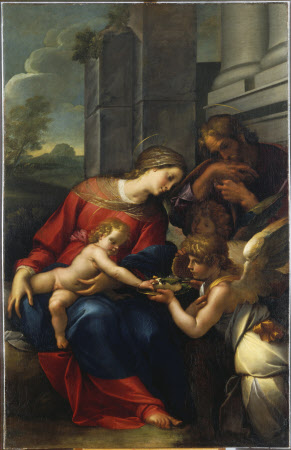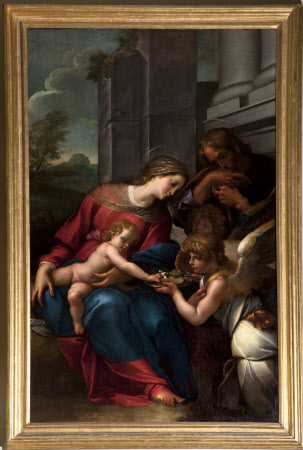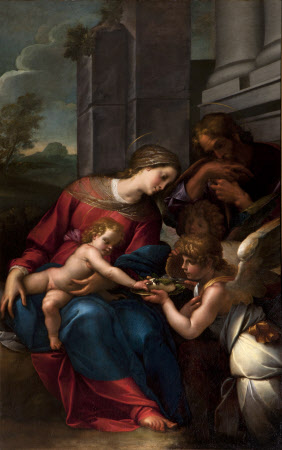The Holy Family with an Angel offering a Honeycomb to the Christ Child
Pier Francesco Mazzucchelli, called Il Morazzone (Morazzone, near Varese 1573 – Piacenza 1626)
Category
Art / Oil paintings
Date
1570 - 1625
Materials
Oil on canvas
Measurements
1930 x 1245 mm (76 x 49 in)
Place of origin
Italy
Order this imageCollection
Kedleston Hall, Derbyshire
NT 108858
Caption
The Holy Family was one of the favourite subjects of this Milanese artist. Formerly attributed to Niccolo dell' Abate, this picture was recorded in the Library at Kedleston in 1769. However, the original painting was recently re-discovered in the Oratory of Santa Maria Maddalena at Moretta and is based on a signed drawing by Morazzone in the Royal Collection. The symbolism of the Christ Child being offered a honeycomb by an angel derives from the biblical book of Isaiah (7:15) in which it is prophesised: “a virgin shall conceive, and bear a son, and shall call his name Immanuel...Butter and honey shall he eat, that he may know to refuse the evil, and choose the good”. And there is an inscription in Latin on the phylactery in the drawing and the Moretta altarpiece which alludes to it: EN MEL A PRVDENS EMANVEL ECCE BVTIRV[?].
Summary
Oil painting on canvas, The Holy Family with an Angel offering a Honeycomb to the Christ Child by Pier Francesco Mazzucchelli, called Il Morazzone (Morazzone, near Varese 1573 – Piacenza 1626). The symbolism of the Christ Child being offered a honeycomb by an angel derives from a biblical reference in Isaiah 7:15 - immediately after the crucial prophecy of: “a virgin shall conceive, and bear a son, and shall call his name Immanuel” is: “Butter and honey shall he eat, that he may know to refuse the evil, and choose the good”. The painting is based upon an autograph drawing by Morazzone in the Royal Collection.
Provenance
Recorded in the Library in 1769 as Niccolò dell'Abate; bought with part of the contents of Kedleston with the aid of the National Heritage Memorial Fund in 1987 when the house and park were given to the National Trust by Francis Curzon, 3rd Viscount Scarsdale (1924-2000)
Credit line
Kedleston Hall, The Scarsdale Collection (acquired with the help of the National Heritage Memorial Fund and transferred to The National Trust in 1987)
Marks and inscriptions
Verso: in chalk on back of lining canvas, in flowing script: Carlo Lutti fecit.
Makers and roles
Pier Francesco Mazzucchelli, called Il Morazzone (Morazzone, near Varese 1573 – Piacenza 1626), publisher previously catalogued as attributed to Giulio Cesare Proccaccini (Bologna.1574 – Milan 1625), publisher previously catalogued as attributed to Nicolò dell'Abate (Modena 1509/12 - Fontainebleau 1571), publisher
References
Laing 2000 Alastair Laing, ‘Morazzone’s ‘Madonna del miele’’, letter in The Burlington Magazine, February 2000, p.112 & fig.78.


